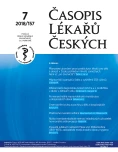Postmenarcheal irregularities in menstrual cycle in adolescent girls
Authors:
Jana Skřenková
Authors‘ workplace:
Gynekologicko-porodnická klinika 1. LF UK a VFN v Praze
Published in:
Čas. Lék. čes. 2018; 157: 343-349
Category:
Review Article
Overview
The first menstrual bleeding, referred to as menarche, albeit an important point in a woman's life, does not yet mean her full sexual maturity.
The hypothalamus-pituitary-ovary axis is fragile during this period and depends on many factors. Their mutual interplay occurs individually and gradually over the next few years, therefore menstrual irregularities of the menstrual cycle occur physiologically, and not all of them need to be regulated. However, it is one of the most frequent reasons for visiting a paediatric gynaecologist’s office.
The average age of menarche in girls in the Czech Republic is 12 years and 6 to 9 months, the physiological limits are 10–15 years. After menarche, anovulation cycles are predominating, resulting in estrogenic activity not controlled by gestagen, which may result in dysfunctional bleeding with subsequent anaemia from blood loss. The opposite possible problem is the absence of menstruation, either primary or secondary.
Correct complete gynaecological examination of adolescent girls with a purposefully thought-out next schematic of laboratory, imaging and counselling examinations leads to the correct diagnosis. This article clearly outlines and breaks down the most common disorders.
The paediatric gynaecologist chooses "tailor-made" treatment with respect to the patient’s age, always strictly individual and justified.
Keywords:
sexual maturity, menarche, menstrual cycle, hormonal cytology, menstrual disorder, anovulation
Sources
1. Hořejší J a kol. Dětská gynekologie. Mladá fronta, Praha, 2017.
2. Skřenková J. Dětská gynekologie. Moderní gynekologie a porodnictví 2015; 23(3): 241–288.
3. Skřenková J. Poruchy menstruačního cyklu u adolescentních dívek. Gynekolog 2018; 2: 56–69.
4. Řezáčová J a kol. Reprodukční medicína: současné možnosti v asistované reprodukci. Mladá fronta, Praha, 2018.
5. Fait T, Šnajderová M a kol. Estrogenní deficit. Maxdorf, Praha, 2007.
6. Lhotská L a kol. V. celostátní antropologický výzkum dětí a mládeže (České země). Zpracování dotazníku pro rodiče. SZÚ, Praha, 1995.
7. Dušková J, Goldová B, Matiášková L et al. Contribution of hormonal cytology in girls and adolescents to reproductive health: a traditional technique monitoring recent problems. Acta Cytologica 2017; 61: 125–132.
8. Papežová H. Anorexia nervosa: příručka pro všechny, kteří trpí nemocí – postižené samotné, jejich rodiny, přátele, partnery a některé odborníky (učitele a lékaře první linie). 2., přepracované vydání. Národní ústav duševního zdraví, Klecany, 2017.
Labels
Addictology Allergology and clinical immunology Angiology Audiology Clinical biochemistry Dermatology & STDs Paediatric gastroenterology Paediatric surgery Paediatric cardiology Paediatric neurology Paediatric ENT Paediatric psychiatry Paediatric rheumatology Diabetology Pharmacy Vascular surgery Pain management Dental HygienistArticle was published in
Journal of Czech Physicians

Most read in this issue
- Disorders of vulva and vagina in children and adolescent
- Premature ovarian failure
- Postmenarcheal irregularities in menstrual cycle in adolescent girls
- The differential diagnostic of pelvic pain at children
